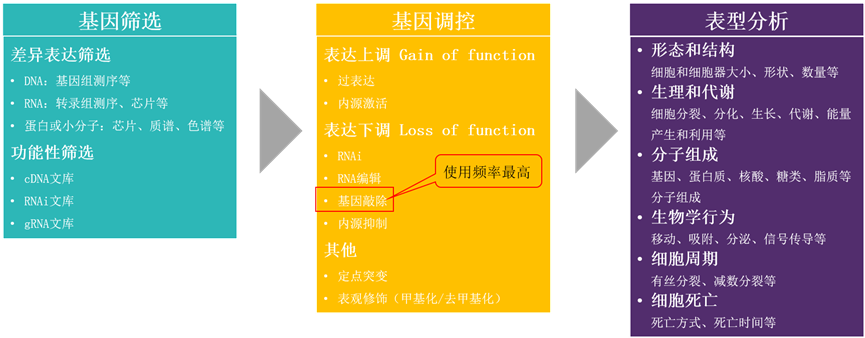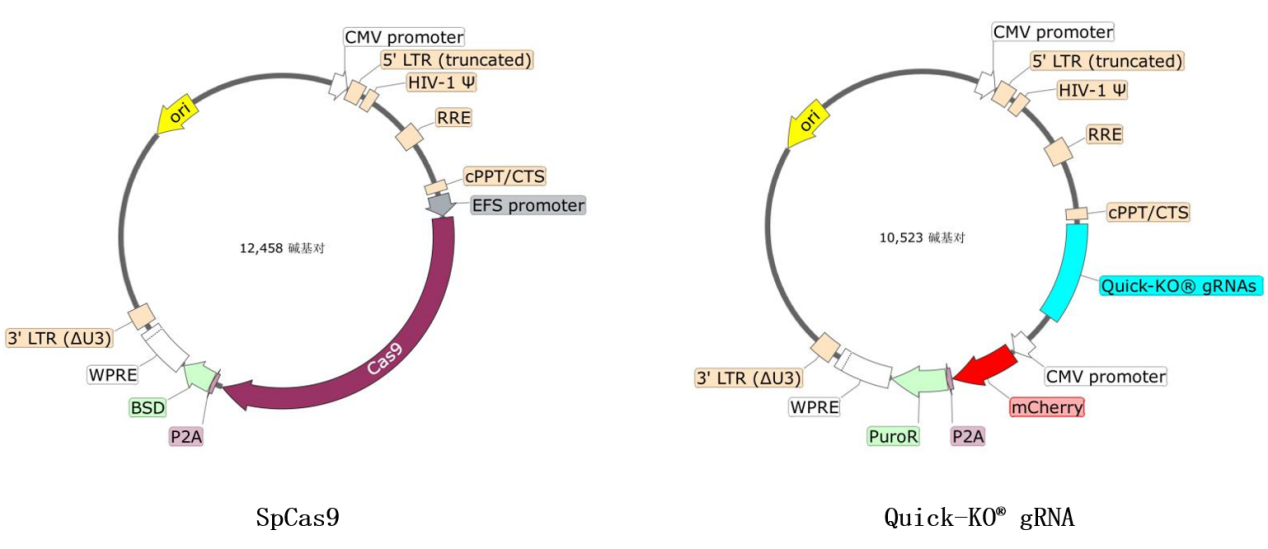在現(xiàn)代生物科技領(lǐng)域,CRISPR-Cas9技術(shù)已經(jīng)成為最受歡迎的基因編輯工具之一。
這種技術(shù)可以用來研究基因功能,疾病診斷和治療等方面。其中最常用的應(yīng)用就是構(gòu)建基因敲除細(xì)胞模型。
本文將介紹CRISPR技術(shù)的基本原理和操作流程,以幫助您更好地了解和使用這種重要的基因編輯工具。

一、CRISPR技術(shù)的基礎(chǔ)原理
CRISPR(Clustered
Regularly Interspaced Short Palindromic Repeats)技術(shù)最初是從大腸桿菌中發(fā)現(xiàn)的一種天然的細(xì)菌防御系統(tǒng),后來被發(fā)現(xiàn)可以被用于基因編輯。
CRISPR-Cas9技術(shù)基于一種叫做“RNA導(dǎo)向”的機(jī)制(guide RNA, gRNA),這種機(jī)制可以讓CRISPR-Cas9系統(tǒng)選擇性地識(shí)別和切割DNA中的特定序列。這意味著我們可以使用CRISPR-Cas9來精確地編輯細(xì)胞中的基因序列,包括基因敲除、插入、替換等等。

二、操作流程
CRISPR-Cas9技術(shù)的操作流程分為四個(gè)主要步驟:設(shè)計(jì)gRNA、構(gòu)建質(zhì)粒、轉(zhuǎn)染細(xì)胞、鑒定細(xì)胞。

1.
設(shè)計(jì)gRNA:gRNA是由CRISPR-Cas9系統(tǒng)識(shí)別并切割目標(biāo)DNA的關(guān)鍵部分。我們需要在目標(biāo)基因中選擇一個(gè)合適的靶點(diǎn)序列,設(shè)計(jì)gRNA來引導(dǎo)Cas9蛋白識(shí)別并切割該序列。
耐思開發(fā)的Quick-KO?基因敲除試劑盒根據(jù)已知的人和小鼠編碼基因,采用優(yōu)化的預(yù)設(shè)計(jì)方案,相較于傳統(tǒng)方案具有更高的敲除效率。
2.
構(gòu)建質(zhì)粒:質(zhì)粒是攜帶CRISPR-Cas9系統(tǒng)和gRNA的載體。在構(gòu)建質(zhì)粒時(shí),我們需要將Cas9基因和gRNA序列克隆到質(zhì)粒中,并確保它們可以在細(xì)胞中穩(wěn)定表達(dá)。
耐思Quick-KO?基因敲除試劑盒中的Cas9質(zhì)粒和gRNA質(zhì)粒分別攜帶Blasticidin和Puromycin/mCherry篩選標(biāo)記,方便用戶進(jìn)行陽性細(xì)胞富集。
3.
轉(zhuǎn)染細(xì)胞:將質(zhì)粒轉(zhuǎn)染到目標(biāo)細(xì)胞中,讓它們表達(dá)CRISPR-Cas9系統(tǒng)并編輯目標(biāo)基因。轉(zhuǎn)染可以通過電穿孔或者化學(xué)轉(zhuǎn)染的方法進(jìn)行。
此外,針對(duì)轉(zhuǎn)染效率低的細(xì)胞,也可以選擇耐思慢病毒款的Quick-KO?基因敲除試劑盒。
4.鑒定細(xì)胞:最后一步是對(duì)成功轉(zhuǎn)染的細(xì)胞進(jìn)行篩選,通過PCR和測(cè)序的方法,篩選出具有目標(biāo)基因敲除的細(xì)胞。
三、目標(biāo)細(xì)胞類型
CRISPR技術(shù)可以用于多種細(xì)胞類型的編輯,包括哺乳動(dòng)物細(xì)胞、酵母菌、昆蟲細(xì)胞和植物細(xì)胞等。
其中,人類細(xì)胞是最常用的細(xì)胞模型之一,可以用于疾病模型的構(gòu)建、藥物篩選和基礎(chǔ)研究等方面。
耐思Quick-KO?基因敲除試劑盒主要針對(duì)人類細(xì)胞、小鼠細(xì)胞等哺乳動(dòng)物細(xì)胞開發(fā)。

對(duì)于不同的目標(biāo)細(xì)胞類型,我們需要根據(jù)細(xì)胞的特點(diǎn)和CRISPR技術(shù)的限制來選擇合適的CRISPR-Cas9系統(tǒng)和轉(zhuǎn)染方法。
四、總結(jié)
基因敲除細(xì)胞模型的構(gòu)建對(duì)于基礎(chǔ)研究和藥物研發(fā)等領(lǐng)域具有重要的意義。CRISPR技術(shù)的出現(xiàn)為基因編輯提供了一種高效、精準(zhǔn)和經(jīng)濟(jì)的方法。在使用CRISPR-Cas9技術(shù)進(jìn)行基因敲除時(shí),我們需要選擇合適的gRNA和基因遞送方法,最終獲得目標(biāo)基因敲除的細(xì)胞模型。
|
細(xì)胞 |
種屬 |
組織/疾病 |
試劑盒方案 |
|
|
質(zhì)粒型 |
慢病毒型 |
|||
|
22Rv1 |
Homo sapiens (Human) |
Prostate |
|
? |
|
293T |
Homo sapiens (Human) |
Kidney; Embryo |
? |
? |
|
4T1 |
Mus musculus (Mouse) |
Breast; Mammary gland |
|
? |
|
A2780 |
Homo sapiens (Human) |
Ovary |
|
? |
|
A-549 |
Homo sapiens (Human) |
Lung |
? |
? |
|
AGS |
Homo sapiens (Human) |
Stomach |
? |
|
|
AML12 |
Mus musculus (Mouse) |
Liver |
|
? |
|
BEAS-2B |
Homo sapiens (Human) |
Bronchus; epithelium |
|
? |
|
BON-1 |
Homo sapiens (Human) |
Pancreas |
? |
|
|
C3H10T1/2 |
Mus musculus (Mouse) |
Embryo |
|
? |
|
CFPAC-1 |
Homo sapiens (Human) |
Pancreas |
? |
? |
|
DU145 |
Homo sapiens (Human) |
Prostate |
|
? |
|
GIST-T1 |
Homo sapiens (Human) |
Gastrointestinal stromal tumor |
|
? |
|
HaCaT |
Homo sapiens (Human) |
Back; skin; epidermis |
|
? |
|
HCC1395 |
Homo sapiens (Human) |
Breast; Duct; Mammary gland |
? |
? |
|
Hela |
Homo sapiens (Human) |
Uterus; Cervix |
? |
? |
|
Hep3B |
Homo sapiens (Human) |
Pediatric hepatocellular carcinoma |
? |
? |
|
Hepa 1-6 |
Mus musculus (Mouse) |
Liver |
|
? |
|
HepG2 |
Homo sapiens (Human) |
Liver |
? |
? |
|
HL-60 |
Homo sapiens (Human) |
Peripheral blood |
? |
? |
|
HMC-1.1 |
Homo sapiens (Human) |
Mast cell leukemia |
|
? |
|
HT-29 |
Homo sapiens (Human) |
Colon adenocarcinoma |
? |
? |
|
Huh-7 |
Homo sapiens (Human) |
Liver, gallbladder |
|
? |
|
HUVEC |
Homo sapiens (Human) |
Umbilical vein |
|
? |
|
IMG |
Mus musculus (Mouse) |
Brain |
|
? |
|
IPEC-J2 |
Sus scrofa (Pig) |
Small intestine; jejunum |
|
? |
|
Jurkat |
Homo sapiens (Human) |
Peripheral blood |
? |
? |
|
K-562 |
Homo sapiens (Human) |
Bone; Marrow |
? |
? |
|
KM12-SM |
Homo sapiens (Human) |
Colon carcinoma |
|
? |
|
LoVo |
Homo sapiens (Human) |
Colon adenocarcinoma |
|
? |
|
MDA-MB-231 |
Homo sapiens (Human) |
Breast adenocarcinoma |
|
? |
|
MEG-01 |
Homo sapiens (Human) |
Bone marrow |
|
? |
|
mIMCD-3 |
Mus musculus (Mouse) |
Kidney; inner medullary collecting duct |
? |
? |
|
MTEC1 |
Mus musculus (Mouse) |
Thymus |
|
? |
|
MCF-7 |
Homo sapiens (Human) |
Invasive breast carcinoma |
|
? |
|
NIH 3T3 |
Mus musculus (Mouse) |
Whole embryo |
|
? |
|
PANC-1 |
Homo sapiens (Human) |
Pancreas; Duct |
|
? |
|
PC-3 |
Homo sapiens (Human) |
Prostate |
|
? |
|
QGP-1 |
Homo sapiens (Human) |
Pancreas; islets of Langerhans |
? |
? |
|
SGC-7901 |
Homo sapiens (Human) |
Uterus; cervix |
|
? |
|
SH-SY5Y |
Homo sapiens (Human) |
Neuroblastoma |
? |
? |
|
SK-HEP-1 |
Homo sapiens (Human) |
Liver; Ascites |
? |
? |
|
SNU-1 |
Homo sapiens (Human) |
Stomach |
? |
? |
|
SW480 |
Homo sapiens (Human) |
Large intestine; Colon |
|
? |
|
T-47D |
Homo sapiens (Human) |
Breast; Mammary gland |
|
? |
|
THP-1 |
Homo sapiens (Human) |
Peripheral blood |
|
? |
|
U-87MG |
Homo sapiens (Human) |
Brain |
|
? |
|
UM-UC-3 |
Homo sapiens (Human) |
Urinary bladder |
|
? |
|
WS1 |
Homo sapiens (Human) |
Skin |
? |
? |
|
CT26 |
Mus musculus (Mouse) |
Colon |
|
? |